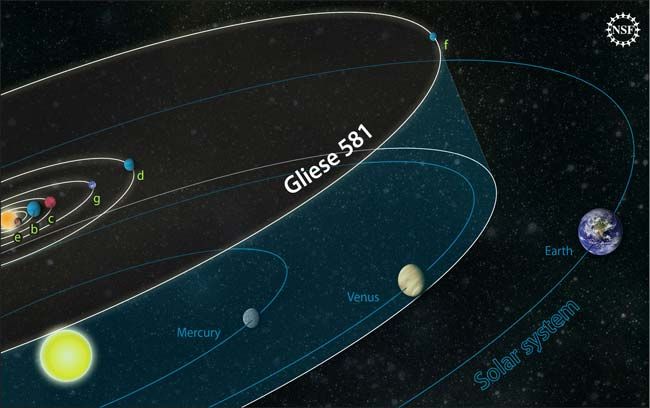
A rocky alien planet called Gliese 581d may be the first known world beyond Earth capable of supporting life as we know it, a new study suggests.
Astronomers performing a new atmospheric-modeling study have found that the planet likely lies in the "habitable zone" of its host star — that just-right range of distances that allow liquid water to exist. The alien world could be Earth-like in key ways, harboring oceans, clouds and rainfall, according to the research.
This conclusion is consistent with several other recent modeling studies. But it does not definitively establish that life-sustaining water flows across the planet's surface.
The new study assumes that Gliese 581d, which is about seven times as massive as Earth, has a thick, carbon-dioxide-based atmosphere. That's very possible on a planet so large, researchers said, but it's not a given. [Video: Life-Sustaining "Super Earth" Gliese 581d]
The Gliese 581 system: Worlds of possibilities
Gliese 581d's parent star, known as Gliese 581, is a red dwarf located 20 light-years from Earth, just a stone's throw in the cosmic scheme of things. So far, astronomers have detected six planets orbiting the star, and Gliese 581d is not the only one intriguing to scientists thinking about the possibility of life beyond Earth.
Another planet in the system, called Gliese 581g, is about three times as massive as Earth, and it's also most likely a rocky world. This planet received a lot of attention when its discovery was announced in September 2010, because it's located right in the middle of the habitable zone. That makes 581g a prime candidate for liquid water and life as we know it — if the planet exists.
Sign up for the Live Science daily newsletter now
Get the world’s most fascinating discoveries delivered straight to your inbox.
Some researchers question the analysis used to discover the planet, and say they cannot confirm 581g in follow-up studies. The planet's discoverers, however, are standing by their find. [The Strangest Alien Planets]
Gliese 581d orbits outside of 581g, far enough away from its star that researchers first thought it too cold for life when it was originally discovered in 2007. But a strong greenhouse effect may warm 581d up substantially, perhaps enough to support liquid water.
That's the tentative conclusion of the new study, as well as several other recent studies by different research teams that also modeled Gliese 581d's possible atmosphere.
Modeling an alien atmosphere
The planet Gliese 581d receives less than a third of the solar energy that Earth does from our sun, and it may be tidally locked (a situation in which one side of the world always faces its sun — a permanent day — and the other faces away, producing eternal night).
After Gliese 581d's discovery, it was generally believed that any atmosphere thick enough to keep the planet warm would become cold enough on the night side to freeze out entirely, ruining any prospects for a habitable climate, researchers said.
The research team tested that possibility in the new study, developing a new kind of computer model that simulates alien planets' atmospheres and surfaces in three dimensions. The model is similar to those used to study climate change on Earth.
When the team ran the model, they found that Gliese 581d probably can indeed host liquid water if it has a dense carbon dioxide atmosphere. Even though the planet is relatively far away from its dim red dwarf parent star, it could be warmed by a greenhouse effect, with daytime heat circulated around the planet by the atmosphere.
The team, led by scientists from the Laboratoire de Métrologie Dynamique (CNRS/UPMC/ENS/Ecole Polytechnique) at the Institut Pierre Simon Laplace in Paris, France, published their results in The Astrophysical Journal Letters.
The work remains speculative.
To determine conclusively if Gliese 581d is truly habitable, future work will probably have to detect and characterize its atmosphere directly. And that is likely years off, since it requires the development of new and advanced telescopes. Human-made probes won't be getting to the planet anytime soon; with current technology, it would take spacecraft hundreds of thousands of years to make the 20-light-year trek.
This story was provided by SPACE.com, a sister site to LiveScience. You can follow SPACE.com senior writer Mike Wall on Twitter: @michaeldwall. Follow SPACE.com for the latest in space science and exploration news on Twitter @Spacedotcom and on Facebook.














